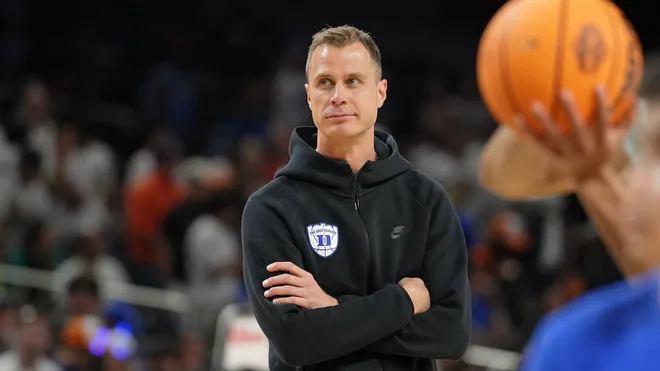In the ever-evolving landscape of college basketball, leadership is one of the most intangible and valuable assets a team can possess. For the Duke Blue Devils, a program historically built on a foundation of elite talent, discipline, and competitive spirit, leadership has taken many forms over the decades—from upperclassmen stalwarts to one-and-done superstars who lead by example. But for head coach Jon Scheyer, now entering his third year at the helm of one of the most scrutinized basketball programs in the nation, leadership this season is coming from an unexpected source: two freshmen. In a recent media session that left fans both surprised and intrigued, Scheyer identified two of his newest players as vocal leaders already leaving their mark on the team’s culture and chemistry. At a time when experience is typically equated with leadership, this revelation is reshaping how the Blue Devils’ locker room is perceived heading into the 2025–26 season.
Scheyer’s comments did more than just name-drop two new faces. They offered a window into the unique dynamic being cultivated in Durham this offseason. It’s not every day that freshmen step into a program as storied and pressure-packed as Duke and immediately begin asserting themselves vocally. Such an assertion requires a rare combination of confidence, basketball IQ, emotional maturity, and the willingness to hold teammates accountable. In the case of the two newcomers Scheyer referenced—who many now believe to be heralded recruits Jalen Haralson and Khaman Maluach—it appears these traits are present in abundance.
For a coach like Scheyer, who has had the unenviable task of succeeding the legendary Mike Krzyzewski, fostering a culture where leadership is democratic rather than strictly hierarchical may be the key to sustaining Duke’s success. Scheyer’s inaugural seasons have been a blend of strong recruiting, tactical experimentation, and culture-building. Though he has drawn praise for his ability to connect with young players and recruit at a high level, questions have lingered about how he would manage locker room dynamics once Coach K’s towering presence faded completely into the background. The emergence of two vocal freshmen as leaders appears to be one of the early signs that the program is developing a culture of accountability and mutual respect, where voices are valued regardless of age or experience.
It’s also a fascinating development in the broader context of college basketball. With the advent of NIL (Name, Image, and Likeness) deals, transfer portals, and increasing player autonomy, the traditional pathways to leadership have shifted dramatically. No longer does leadership automatically default to seniors or returning players; rather, it often stems from those with the most professional readiness or internal drive. In this case, the freshmen in question have not only arrived with elite skill sets but also with the mindset of seasoned veterans. This mentality is exactly what separates good teams from great ones.
Scheyer has spoken before about the importance of “player-led teams” over “coach-led teams,” a mantra that has found success at many top-tier programs. Coaches can design the best offensive sets and defensive schemes in the world, but when the game tightens and adversity strikes, it’s the players who must communicate, adapt, and execute. By identifying these freshmen as vocal leaders early in the offseason, Scheyer may be nudging the rest of the roster toward a more cohesive and self-sustaining form of accountability—one that transcends age or tenure in the program.
What’s also striking is how Scheyer has framed the idea of vocal leadership. This isn’t simply about trash talk during practice or empty cheerleading on the sidelines. Vocal leadership in Duke’s current context is about setting a standard, demanding effort from peers, directing on-court traffic, correcting mistakes, and providing constant encouragement. It’s the voice that rallies the huddle when the team is down ten. It’s the shout that reminds teammates of their assignments in the middle of a fast break. It’s the unseen presence that often determines whether a team collapses under pressure or rises to the moment.
The timing couldn’t be better either. Duke enters this season with a healthy mix of returning talent and fresh faces, but there isn’t a clear alpha in the mold of past leaders like Christian Laettner, Shane Battier, or even more recent figures like Grayson Allen. That vacuum creates a powerful opportunity—for someone bold enough to take the reins. By stepping up as vocal leaders so early, the two freshmen are signaling to both teammates and fans that they are here to do more than just score points or collect accolades. They’re here to shape the direction of the team.
That boldness has not gone unnoticed by teammates. In closed-door practice sessions and summer workouts, insiders report that the two freshmen have been among the most vocal in calling out lapses in effort and celebrating good execution. They’ve reportedly shown no hesitation in pushing older players, even upperclassmen, to raise their level of play. That kind of dynamic can sometimes create friction, but in Duke’s case, it appears to be doing the opposite—sparking mutual respect and elevating the competitive environment.
The evolution of leadership styles under Jon Scheyer also marks a distinct departure from the Krzyzewski era, where seniority often dictated roles. Scheyer, more attuned to the modern player’s psyche, has opened the floor for leadership to be earned, not assigned. That approach resonates deeply with today’s athletes, many of whom come from elite high school programs or international clubs where they were already expected to be leaders. Giving them the opportunity to lead from day one empowers them and accelerates their integration into the team’s culture.
This isn’t to say that the veterans on the team are fading into the background. On the contrary, having vocal freshmen has reportedly re-energized the older players, who now feel both a sense of pride in mentoring and a renewed urgency to lead by example. The internal competition has bred a more intense and focused environment in practice. And in a season where every possession matters—especially for a team with national championship aspirations—that heightened intensity could prove invaluable.
It also reflects well on the recruiting process. Scheyer and his staff didn’t just target highly-rated prospects—they targeted personalities, competitors, and students of the game. Bringing in players with the courage to speak up in a room full of future NBA talent isn’t easy. But when you nail that evaluation, you don’t just get talent—you get leaders, culture drivers, and difference-makers. That’s the kind of recruiting that sustains success year after year.
The fans have taken notice, too. Duke’s fan base, arguably the most passionate in college basketball, thrives on stories of grit, passion, and emotional investment. Learning that two freshmen are already helping set the tone in practices has ignited optimism across social media platforms and message boards. Many are already speculating whether these freshmen could become fan favorites—not just for their performances on the court, but for their visible leadership, fire, and commitment to team success.
Of course, words must eventually be backed up by actions. The real tests will come when Duke faces its toughest competition—when the bright lights of the ACC schedule illuminate both strengths and weaknesses. But having freshmen already equipped with a vocal presence and a leadership mindset is a major advantage. It means that when adversity comes, the team won’t have to look around wondering who will speak up. The voices are already there. And they’re already being heard.
For Jon Scheyer, the ability to nurture that kind of environment speaks volumes about his growth as a head coach. The decision to publicly highlight these two freshmen is also a tactical one—by doing so, he’s putting wind in their sails, reinforcing their value, and sending a message to the entire roster: leadership isn’t age-dependent; it’s earned. It also shows that Scheyer isn’t afraid to buck tradition in favor of what works. And what appears to be working is a player-led, merit-based approach to leadership that’s already bearing fruit before the first tip-off.
As Duke gears up for what promises to be another high-stakes season in the always-competitive world of college basketball, the foundation is being laid not just with skill and strategy but with voice and vision. Two freshmen, unburdened by the fear of overstepping, have stepped into roles that few would have expected them to embrace so early. Their emergence as vocal leaders may very well be the X-factor in a season where the margins between elite and average are razor-thin. And in the high-stakes theater that is Cameron Indoor Stadium, their voices could soon echo far beyond the locker room.



